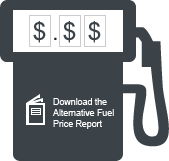Renewable Diesel
Renewable diesel is a fuel made from fats and oils, such as soybean oil or canola oil, and is processed to be chemically the same as petroleum diesel. It meets the ASTM D975 specification for petroleum in the United States but not the minimum density requirement of 0.820 kg/m3 in the EN 590 petroleum diesel standard in Europe. Renewable diesel does meet the EN15940 standard for paraffinic diesel fuels. Renewable diesel can be used as a replacement fuel or blended with any amount of petroleum diesel. Nearly all domestically produced and imported renewable diesel is used in California due to economic benefits under the Low Carbon Fuel Standard.
Renewable diesel and biodiesel are not the same fuel. Renewable diesel, previously known as green diesel, is a hydrocarbon produced most often by hydrotreating and also via gasification, pyrolysis, and other biochemical and thermochemical technologies. It meets ASTM D975 specification for petroleum diesel. Biodiesel is a mono-alkyl ester produced via transesterification. Biodiesel meets ASTM D6751 and is approved for blending with petroleum diesel.
Production
Renewable diesel can be produced by several different technology pathways. Currently, commercial production facilities are using the hydrotreating pathway, with fats, oils, and greases as the most common feedstocks. There are several technology pathways to produce renewable diesel including:
-
Traditional hydrotreating—Used in petroleum refineries, hydrotreating involves reacting the feedstock (lipids) with hydrogen under elevated temperatures and pressures in the presence of a catalyst. Commercial plants currently use this technology.
-
Biological sugar upgrading—This pathway uses a biochemical deconstruction process, similar to that used with cellulosic ethanol with the addition of organisms that convert sugars to hydrocarbons.
-
Catalytic conversion of sugars—This pathway involves a series of catalytic reactions to convert a carbohydrate stream into hydrocarbon fuels.
-
Gasification—During this process, biomass is thermally converted to syngas and catalytically converted to hydrocarbon fuels.
-
Pyrolysis—This pathway involves the chemical decomposition of organic materials at elevated temperatures in the absence of oxygen. The process produces a liquid pyrolysis oil that can be upgraded to hydrocarbon fuels, either in a standalone process or as a feedstock for co-feeding with crude oil into a standard petroleum refinery.
-
Hydrothermal processing—This process uses high pressure and moderate temperature to initiate chemical decomposition of biomass or wet waste materials to produce an oil that may be catalytically upgraded to hydrocarbon fuels.
The past two years have seen tremendous growth in new plants, many of which are located in western states and were converted from existing petroleum refineries. Additional large plants are expected to come online through 2024. The United States continues to import from Neste, an international producer that has plants in several European countries and Singapore.
| Plant Name | Location | Capacity (mmgy) |
|---|---|---|
| BP Products North America | Blaine, WA | 66 |
| CVR Energy Inc | Wynnewood, OK | 100 |
| Chevron Renewable Energy Group | Geismar, LA | 470 |
| Chevron Renewable Energy Group | El Segundo, CA | 31 |
| Diamond Green Diesel | Norco, LA | 982 |
| East Agri-Energy | Gannett, KS | 3 |
| HF Sinclair | Artesia, NM | 125 |
| HF Sinclair | Cheyenne, WY | 90 |
| HF Sinclair | Sinclair, WY | 117 |
| Kern Oil & Refining | Bakersfield, CA | 6 |
| Marathon Petroleum | Dickinson, ND | 184 |
| Marathon Petroleum | Martinez, CA | 260 |
| Montana Renewables | Calumet, MT | 175 |
| Phillips 66 | Rodeo, CA | 120 |
| Seaboard Energy | Hugoton, KS | 85 |
| World Energy | Paramount, CA | 42 |
| Total | 2,856 |
Benefits
Renewable diesel offers many benefits, including:
-
Engine and infrastructure compatibility—Renewable diesel meets the conventional petroleum ASTM D975 specification allowing it to be used in existing infrastructure and diesel engines.
-
Fewer emissions—An NREL study found renewable diesel reduced both carbon dioxide and nitrogen oxide emissions when compared with petroleum diesel. California's Low Carbon Fuel Standard Certified Carbon Intensities shows renewable diesel reduces carbon intensity on average by 65% when compared with petroleum diesel.
-
More flexibility—Renewable diesel is a replacement for diesel and can be used to fully replace diesel or blended with any amount. Renewable diesel can be made from multiple feedstocks, and it can be made at plants that also produce sustainable aviation fuel.
Research and Development
The U.S. Department of Energy's national laboratories have explored methods to overcome barriers to renewable diesel scale-up and demonstration including feedstock and production cost challenges.
- Biochemical Hydrocarbon Pathways
- Biological Conversion of Sugars
- Thermochemical Hydrocarbon Pathways
- In Situ and Ex Situ Pyrolysis
- Updated Fast Pyrolysis Design
- Algae Hydrocarbon Pathways
- Whole Algal Hydrothermal Liquefaction and Upgrading
More Information
Learn more about renewable diesel from the links below. The Alternative Fuels Data Center (AFDC) and U.S. Department of Energy do not necessarily recommend or endorse these organizations (see disclaimer).
- Clean Fuels Alliance America (formerly National Biodiesel Board)
- Advanced Biofuels Association
The AFDC also provides a publications search for more information. Email the Technical Response Service or call 800-254-6735 with questions.
